
Almanac
New Zealand
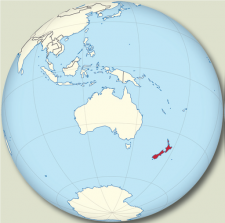
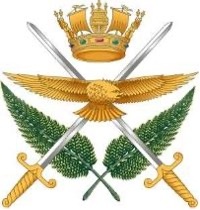

Surgeon General
Charmaine Tate
Brigadier
Source: Ministry of Defence New Zealand
The Military Health Services of New Zealand
History
The earliest medical care in New Zealand were practices developed and adapted by the Māori after migrations from Polynesia beginning around 1200AD. Now known as Rongoā, this system of treatments has a holistic basis combining prevention, family and spiritual support, massage and the use of medicinal flora. Rongoā sustained toa [warriors] during competition over resources and prestige.
The first European medical care was delivered by naval surgeons aboard visiting ships, the first under Abel Tasman in 1642. After Captain Cook’s expedition in 1769 Europeans arrived in increasing numbers.
In 1840 New Zealand’s founding document, Te Tiriti-o-Waitangi (The Treaty of Waitangi), was signed between around 500 Māori chiefs and the British Crown. Five years later a series of regional conflicts began, known as the New Zealand Wars, as Māori tribes responded to encroachment. During these conflicts a nascent Colonial Medical Service formed. Initially Medical care was informal – most units employed a Surgeon and Orderly. Co-ordination between units was required by the needs of units dispersed while patrolling and skirmishing over rough terrain. Māori established fortified Pa with complex earthworks above and below ground. The occasional but intense assaults onto these presented new problems for medical care. At the battle of Gate Pa a no-mans-land developed, where wāhine toa [woman warrior] Hēni Te Kiri Karamū, and Assistant Surgeon William Manley (VC) were both recognised for their bravery and compassion caring for the wounded. These larger battles spurred national structuring of medical resources. By the 1870s as national conflict had culminated, a medical service had evolved and continued to develop as New Zealand’s military focus shifted to supporting the British Empire and perceived external threats. Towards the end of this period Medical Service staff deployed with the volunteer contingents to the Anglo-Boer War.
The New Zealand Medical Corps was founded in 1908, as the New Zealand Government sought to rebuild the Defence Force and improve its governance. The new structure improved standards and training, preparing medical elements for difficult assignments during the First World War, including the Anzac contribution to the Gallipoli campaign, and the fighting at Passchendaele during the Third Battle of Ypres. To meet the scale of the First World War deployments the New Zealand Dental Corps and the New Zealand Nursing Corps were established early in 1915.
In the 1930s the Air Force Act led to the formation of the Royal New Zealand Airforce, requiring surgeons to be enlisted with ground support units.
These structures served the NZDF throughout the Second World War and subsequent conflicts. Royal titles were granted from the late 1940s onwards.
In the 2010s NZDF medical units came under the Joint Support Group, to co-ordinate resources across the three services, and under the governance of the Defence Health Directorate. Corps and service identities were retained.
National Context and Summary
New Zealand: Overview and Geostrategic Position
New Zealand is an island nation in the South West Pacific, located on the volcanic Pacific Ring of Fire. The North Island (Te lka-a-Māui [The Fish of Māui]) and the South Island (Te Waipounamu [The Waters of Greenstone/Jade]) make up the majority of the nation’s 268 838km2 landmass, arranged roughly north to south along the Pacific and Australian plate boundary. The nation is narrow with no point more than 120km from the sea, rising from the coast to alpine areas, especially in the south.
New Zealand has a large Exclusive Economic Zone (EEZ) over 4000000km2 –15 times greater than its landmass. The EEZ is bolstered by the UNCLOS recognised continental shelf of Zealandia, and smaller outlying islands including the Kermadec Islands to the north, Campbell and Auckland Islands to the south and south west, and the Chatham Islands to the east.
Beyond the EEZ the New Zealand military is required to support further dependencies and nations. To the south is the Ross Dependency claimed under the Antarctic Treaty, with a permanent
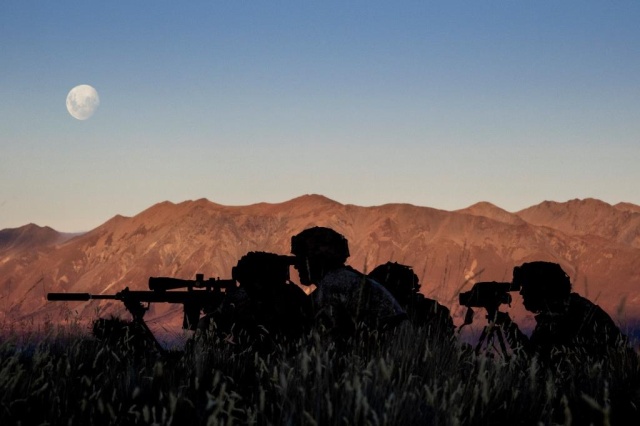
Soldiers training in the Mackenzie Basin of the South Island of New Zealand. (Photo by New Zealand Defence Force)
research presence at Scott Base. To the north within the Pacific Ocean New Zealand is legislated to support Niue, Tokelau and the Cook Islands, and is committed to supporting nations in the south pacific, including fellow Commonwealth states. Ongoing military support includes search and rescue, security, peacekeeping, fisheries patrols, and humanitarian aid and disaster relief.
Organisation of the Ministry of Defence and Armed Forces
As a Commonwealth Realm, the New Zealand Defence Force is headed by King Charles III, who is represented by a New Zealand appointed Commander-in-chief, the Governor-General.
The direction of Defence is set by the Minister of Defence, selected from within the elected government. The minister is advised by the Ministry of Defence, which maintains continuity of planning and defence relationships under its CEO, the Secretary of Defence.
The Defence Force is commanded by the Chief of Defence (CDF), and the three Service Chiefs –Chief of Navy (CN), Chief of Army (CA), and Chief of Air Force (CAF). The Chief of Defence may be appointed from any one of the three services. Under the Service Chiefs sit the force component commands which each control maritime, land, air, and special operations.
Deployed forces fall under a joint structure – the Headquarters Joint Forces New Zealand (HQJFNZ), under the Commander Joint Forces New Zealand (COMJFNZ)
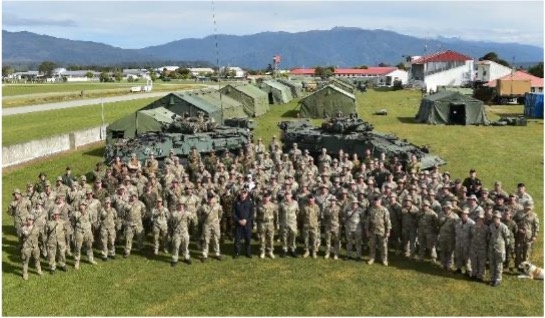
His Majesty King Charles III visiting Defence Personnel, including Deployable Health Organisation members, during an Exercise in Westport, West Coast District of the South Island of New Zealand. (Photo by New Zealand Defence Force.)
National Health System
Healthcare in New Zealand is largely government funded, organised under the Ministry of Health/Manatū Hauora. The health system is designed to manage the challenges created by a low population density of 19 people per km2. This requires co-ordinating health delivery and access for smaller and remote districts such as the West Coast in the South Island, given that specialist services must be clustered in main centres such as Auckland, Wellington and Christchurch.
The ministry administers legislation and regulations for health, and provides leadership to the health system. The provision of healthcare is the responsibility of Health New Zealand, working through 14 District Health Boards that directly administer hospitals. Primary Healthcare is delivered mostly through private practices, with some targeted government funding.
Within the system health provision for Māori must be guided by New Zealand’s founding document, Te Triti-o-Waitangi (The Treaty of Waitangi), signed between Māori representatives and the British Crown in 1840. The three articles of the treaty allow the Crown to govern, and require protection for Māori, and equal rights. The treaty is interpreted through principles, with healthcare principles set by the Waitangi Tribunal’s Hauora report (2019), which are—
Self-determination (Tino rangatiratanga)
Equity
Active protection
Options for culturally appropriate delivery
Partnership
New Zealand Defence Force Health System
Defence Health provides healthcare services to the members of the Defence Force. Health services have three principal roles and through the operations and functions support—
1. The maximisation of the Armed Forces’ operational effectiveness.
2. The creation of a readily deployable health support capability that can operate with flexibility and agility.
3. The provision of robust benchmarked health governance to the Defence Force.
Recipients of Health services provided by the Defence Force can expect equitable care, and standards of care better or equal to services as exists from New Zealand public health and disability services, or when deployed, as near to those standards as are achievable. Defence health providers are regulated by professional and ethical standards under New Zealand legislation.
NZDF has adopted the Te Whare Tapa Whā model of health to prepare deployed forces to carry out their duties in the best overall health. The model describes four ridge poles that support overall health: Te taha hinengaro (psychological health); te taha whānau (family health); Te taha tinana (physical health); and Te taha wairua (spiritual health). This ties wider military traditions into health including chaplaincy and psychological support, aligns with Te Triti-o-Waitangi principles, and recognises the WHO concept of health as not only the absence of injury, disease or infirmity, but as a state of fitness and well-being.
The Defence Health system is organised to provide health functions operationally and domestically. These functions include, but are not limited to heath governance, primary medical and dental healthcare, limited inpatient services; emergency medical care; medical evacuation; health intelligence; force health protection; operational planning and support; health logistics; physical and mental health conditioning; community and social services; and spiritual services.
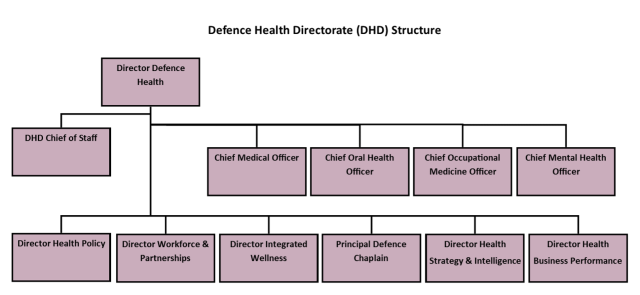
Source: Ministry of Defence New Zealand
The Defence Health Directorate (DHD) provides governance and leadership. Headed by the Surgeon General (SG), appointed by the Chief of the Defence Force (CDF), and reporting to the Chief People Officer (CPO) of the NZDF. The Surgeon General is health regulator, the principal professional technical health expert, and the overall lead for Defence Health’s services. The position can only be held by a registered health practitioner, and can alternatively be titled Director of Defence Health (DDH) as may be appropriate for the profession of the incumbent. The Surgeon General is also the authorising authority for the practice of medics and other NZDF health care workers not otherwise regulated under New Zealand legislation.
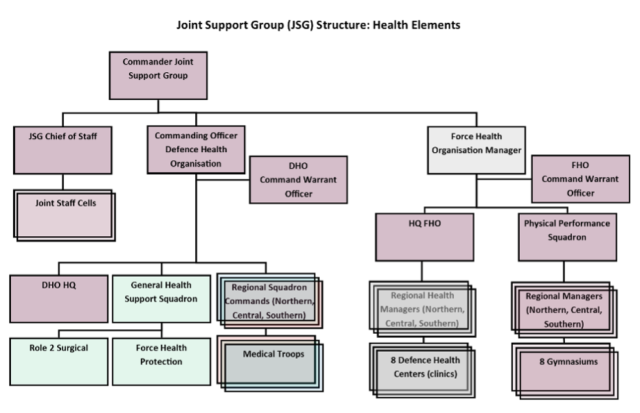
Source: Ministry of Defence New Zealand
The Joint Support Group (JSG) reports to the Land Component Commander (LCC) and provides economy and unity of effort across joint support functions, including a health sub-command. Within the health sub-command, healthcare delivery is divided between the Deployable Health Organisation (DHO) and the Force Health Organ
The Deployable Health Organisation provides deployed Health Support for both operations and exercises up to and including a Role 2 surgical capability. Trades and roles include-
Medics supporting primary healthcare care and evacuation, specialised to support one of the domains of land, sea, air, or for special operations.
Credentialed medical specialists to conducting emergency care, medical evacuation, resuscitation, or surgery.
Force Health Protection (FHP) specialists trained in environmental and occupational health, working to reduce or eliminate the incidence of disease and non-battle injury.
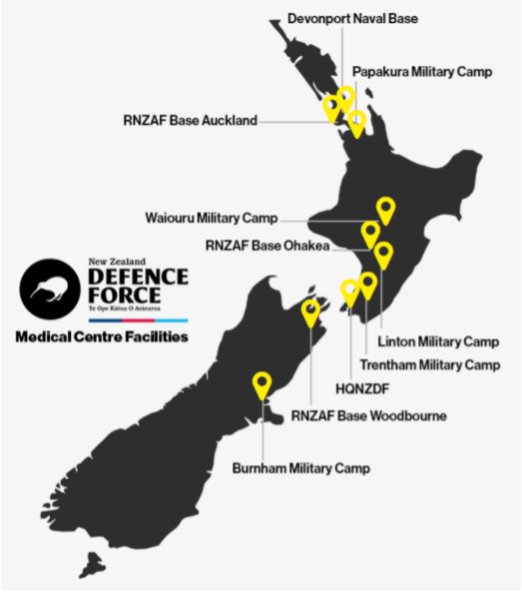
Source: Ministry of Defence New Zealand
Map of the locations of Defence Health Locations in New Zealand. A Defence Health Centre (DHC) clinic, and dental treatment centre is located at each camp or base. The Defence Health Directorate is located in Wellington, within the Headquarters New Zealand Defence Force(HQNZDF). The Joint Support Group (JSG) and Force Health Organisation (FHO) headquarters are co-located in Trentham Military Camp, while the Deployable Health Organisation (DHO) is headquartered in Linton Military Camp.
Force Health Organisation delivers primarily health within camps and bases, has the lead role of preparing NZDF military personnel as ‘health fit’ and ‘health ready’ for operations, and supports health tasks within New Zealand. Force Health maintains facilities including dental centres, gymnasiums, health centres, rehabilitation facilities, and performance health research. New Zealand based support tasks include aeromedical evacuation and Search and Rescue (SAR) response, the delivery of health support to meet international runway airworthiness standards, and provision of health related National Contingency (NATCON) needs.
The Aviation Medical Unit (AMU) provides aerospace medicine expertise to manage the health and safety of pilots and aircrew. It also delivers specific aeromedical training and related development and research, and maintains strategic aeromedical evacuation services. A vital output of the unit is hypobaric training, preparing pilots and aircrew to respond to life-support malfunction at high altitude. The unit operates under the Directorate of Air Force Safety and Health (DASH), but maintains links with the wider health services and healthcare workforce.
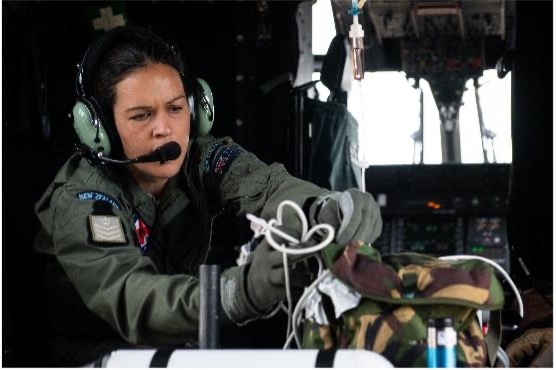
NZDF Medic tends to a patient during an exercise aboard a No. 3 Squadron RNZAF NH-90 Helicopter. (Photo by New Zealand Defence Force)
J1 Health (J1H) is the specific branch tasked with planning, and commanding health elements within a deployment. This branch sits within Joint Forces Headquarters New Zealand (JFHQNZ) which has overall responsibility for command and planning of forces deploying outside of New Zealand.
Health Services Support manages all aspects of Integrated Logistics Support (ILS): chain management, transportation, and health support for all equipment and materiel. This includes biomedical/electrical repair, consumables, blood products, and pharmaceuticals. Range covers deployed and non-deployed medical treatment clinics, and gymnasiums. It also manages the NZDF medical store, which is responsible for the repackaging of medications that enables Medics and other qualified staff to issue medications under the Defence Medical Treatment Protocols. Logistic supply and deployed logistics are supported by health’s Logistic Support Squadron, who maintain the skills required for managing health material for the Deployable Health Organisation.
The Defence Health School trains medics in a tri-service course, and operates courses in medical planning for medical staff-officers.
Training
The Defence Health School is the NZDF's 'centre of excellence' for NZDF medical and health training. The school provides training that develops the knowledge, skills an attitudes required of NZDF personnel in order to prepare them for operational and domestic health roles. The Defence Health School provides initial training for all NZDF medics including delivery of the Military Medical Technician and Medic courses, and acts as course controller for training for health-related roles and health training provided by other NZDF health units.
Specialist officers such as Nurses, General Practitioners, Surgeons and Allied Health are usually recruited after training and qualifying in their respective professions, but in some instances study is paid. They are supported in their military skills development through funding of continuing professional development programs. Training through staff placements into civilian hospitals or with first responders occurs for specific trades, allowing staff to meet important qualification needs. This allows professional registration and competency to be maintained as required by the Health Practitioners Competency Assurance Act (2003).
Deployable uniformed staff may also facilitate their training in primary medicine through rotations into Defence Health Centres if appropriate. This is especially relevant to training and qualifying in the Defence Medical Treatment Protocols.
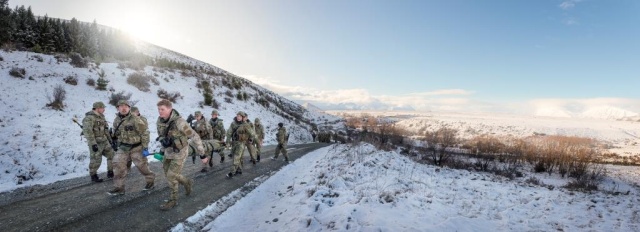
Defence Health School medics training during a field phase of their study, in the Tekapo Military Training area. (Photo by New Zealand Defence Force)
Defence Medical Treatment Protocols
The Defence Medical Treatment Protocols enable medical staff, especially qualified Medics, to deliver clinically appropriate care and issue pharmaceutical treatments when a registered medical practitioner or other prescriber is not present. The Defence Medical Treatment Protocols have been written primarily to stabilise a patient and enable timely and quality care, within safe bounds. Treatment is designed for an austere environment, delivered to New Zealand Defence Force (NZDF) personnel, and in some circumstances non-NZDF personnel. As well as allowing critical care to be distributed more widely, the Defence Medical Treatment Protocols create a focus for training and skills, and the selection of appropriate medications and equipment.
Healthcare Staff
Uniformed health staff are made up of members of the Regular Force (full time) or Territorial Force (Reserve Force), with some roles exclusively Reserve Force, including surgeons. Civilian staff are also critical to delivery of Defence Health Services in New Zealand based roles, such as selected health leadership and policy positions, and in Force Health roles including General Practitioners, Nurses, and Dentists.
Military staff may be enlisted medics trained by the NZDF, specialist officers recruited for their speciality civilian qualifications, and non-medically trained general-list officers in health command and staff positions.
As a joint service, health staff typically serve their careers under the service they initially join. When appropriate staff from one service may post into positions in a differing service, serving as an important means of transferring service knowledge and skills. Trade and core changes can be facilitated with appropriate qualification.
Recruiting
Recruiting of NZDF Health staff can occur via a number of pathways according to role. These range from direct entry, internal recruiting, and enlisting trained medical specialists. The NZDF also benefits from recruiting staff from aligned militaries, subject to appropriate clearance.
An NZDF Health Recruiting portfolio advises NZDF recruiting and advertising, and supports activities at medical gatherings and events. Recruiting is assisted by number of options to internally recruit, retain, and reenlist staff. These include supporting medical students to serve in the reserve force, facilitating movement between reserve forces and full time service, and offering work flexibility including altered hours and parental support to retain staff. Health specific remuneration is maintained, helping to meet changes in the pay of civilian healthcare workers.
Operations and tasks
The NZDF maintains readiness, and deploys people within its territory, dependencies, and regionally within the pacific. It also deploys personnel globally in support of United Nations tasks, and in concert with aligned nations. Below are example operations, indicating of the types of deployments the NZDF undertakes, and may undertake in the near future.
Operations and activity in the Pacific
The NZDF participates extensively in the Pacific region, working with partnered nations, under a number of titled Operations and other activities. Tasks include security operations such as the Regional Assistance Mission to Solomon Islands (RAMSI), fisheries monitoring, search and rescue, and frequent disaster relief operations to events such as cyclones, volcanic eruptions and drought. Active healthcare activities are also combined with exercises in the region, providing dental, primary health, and other healthcare to remote communities. These include the longstanding exercise series Tropic Twilight, and Pacific Partnership, alongside the United States, Australia and other supporting nations.
The response to the Covid-19 pandemic
NZDF personnel deployed domestically and globally in a variety of roles. By far the most significant was within New Zealand under Operation Protect which continued until the latter half of 2022. During this time New Zealand successfully eliminated Covid-19 and went on to maintain levels that significantly minimised public and healthcare disruption. NZDF staff provided planning, management and security support to the quarantine of international travellers.
Within the Pacific NZDF ships and aircraft delivered vaccines to Niue, Tokelau, and the Cook Islands, while medical and diagnostic support was deployed to a number of international operations and tasks.
Afghanistan- Multiple Operations
NZDF staff including specialist health personnel were active in Afghanistan for over 10 years delivering against a number of different mission outputs. Medical support covered direct support to NZDF forces, and integration of medical professionals into coalition medical facilities.
Operation Manawa
Part of New Zealand’s wider support to the Defeat ISIS Coalition, Op Manawa was a series of rotations of company sized contingents training members of the Iraqi Armed Forces at camp Taji. Deployed in support were force health protection officers and a range of medical staff who worked with Australian Defence Force counterparts. This included a range of professions including Surgeons, Nurses, General Practitioners, Medics, and Force Health Protection officers.
Response to the Whakaari/White Island Eruption
Whakarri/White Island is an active volcano 48km off the coast of the North Island of New Zealand. After tour groups totalling 47 people were caught in an explosive steam eruption, the NZDF provided significant and rapid assistance. As part of a co-ordinated response with emergency services, Headquarters Joint Forces New Zealand (HQJFNZ) organised critical support to the recovery, including aerial reconnaissance, naval vessels, and personnel. Patients were transferred from the local hospital to specialist burns centres in Auckland and Lower Hutt using RNZAF NH90 helicopters. Members of the Explosive Ordinance Disposal squad worked to recover human remains from the still active volcano with significant Health Support planning, while members of the Royal New Zealand Dental Corps and other service personnel assisted with disaster victim identification.
Monitoring, Supervision and Observing
New Zealand participates in a number of UN and multi-national missions, including long running missions such as the Multi-national force and observers in the Sinai Peninsular, Egypt, and the United Nations Truce Supervision Organisation mission, specifically in the Golan Heights and Lebanon. Medical staff frequently deploy on these missions, operating in non-medical roles.
Operation Āwhina and Domestic Support
Āwhina is a series of operations arising from NZDF contingency planning for national disasters. The series includes the response to the sinking of the MV Rena and resulting fuel oil spill, and the 2023 response to unprecedented flooding in Gisborne and the Hawke’s Bay. Related operations include Op Canterbury Quake, responding to the 2011 earthquake which devastated the region, and the response to the 2016 magnitude 7.8 Kaikōura earthquake which isolated the region, requiring extensive evacuation of civilians, and resupply by land and sea.
References:
Manatū Taonga/Ministry for Culture and Heritage history resources (mch.govt.nz, nzhistory.govt.nz, TeAra.govt.nz)
Te Puna Mātaranga o Aotearoa/National Library of New Zealand (natlib.govt.nz)
Manatū Aorere/New Zealand Ministry of Foreign Affairs and Trade (mfat.govt.nz)
Manatū Hauora/Ministry of Health (health.govt.nz)
New Zealand Defence Force (nzdf.mil.nz)
New Zealand Army Publication NZ-P-77 “Why?”
(status: 9th September 2024)











